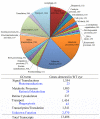Chemistry and biology of vision
- PMID: 22074921
- PMCID: PMC3265841
- DOI: 10.1074/jbc.R111.301150
Chemistry and biology of vision
Abstract
Visual perception in humans occurs through absorption of electromagnetic radiation from 400 to 780 nm by photoreceptors in the retina. A photon of visible light carries a sufficient amount of energy to cause, when absorbed, a cis,trans-geometric isomerization of the 11-cis-retinal chromophore, a vitamin A derivative bound to rhodopsin and cone opsins of retinal photoreceptors. The unique biochemistry of these complexes allows us to reliably and reproducibly collect continuous visual information about our environment. Moreover, other nonconventional retinal opsins such as the circadian rhythm regulator melanopsin also initiate light-activated signaling based on similar photochemistry.
Figures




References
-
- Fein A., Szuts E. Z. (eds) (1982) Photoreceptors: Their Role in Vision, Cambridge University Press, Cambridge
Publication types
MeSH terms
Substances
Grants and funding
LinkOut - more resources
Full Text Sources

